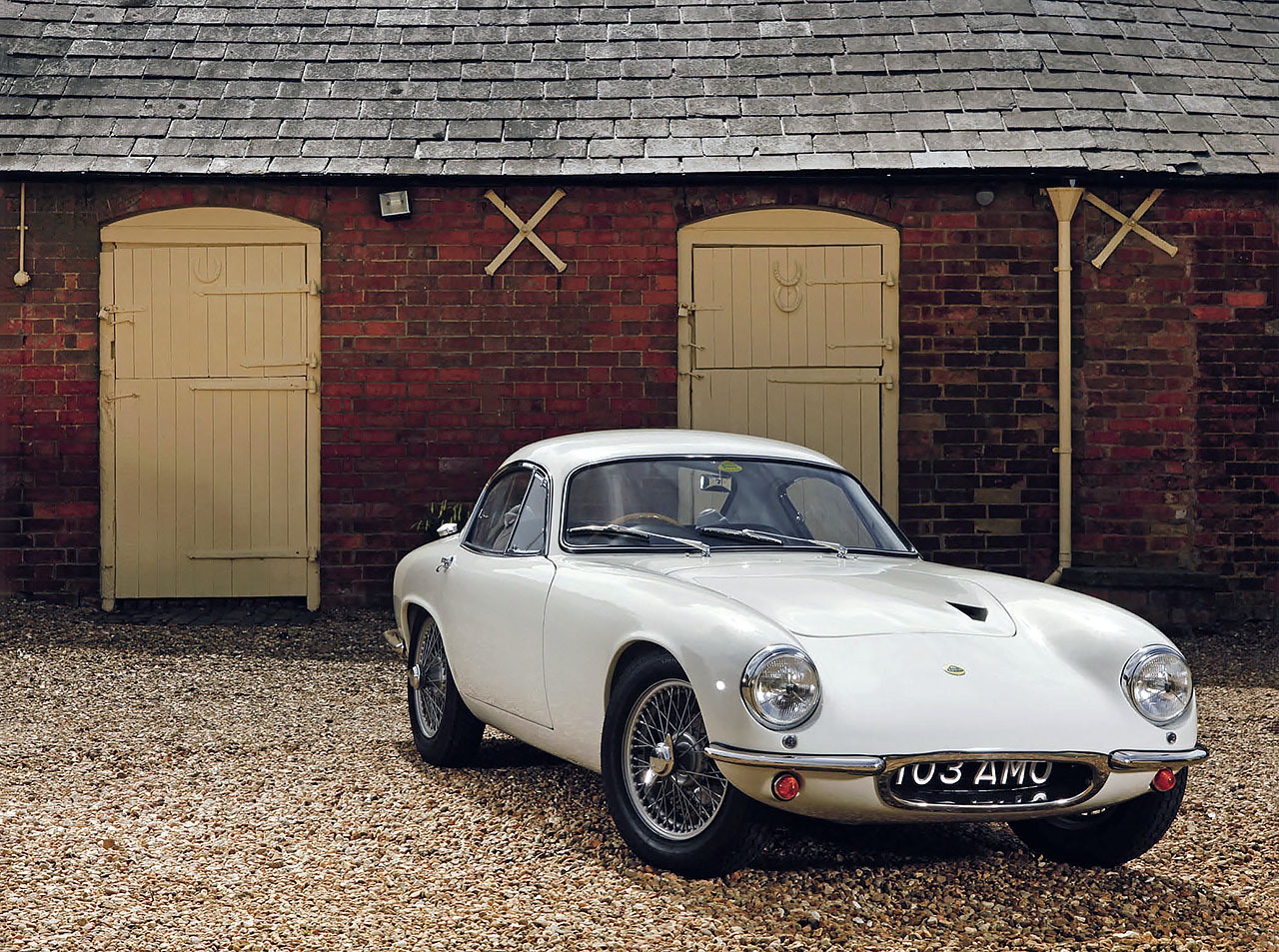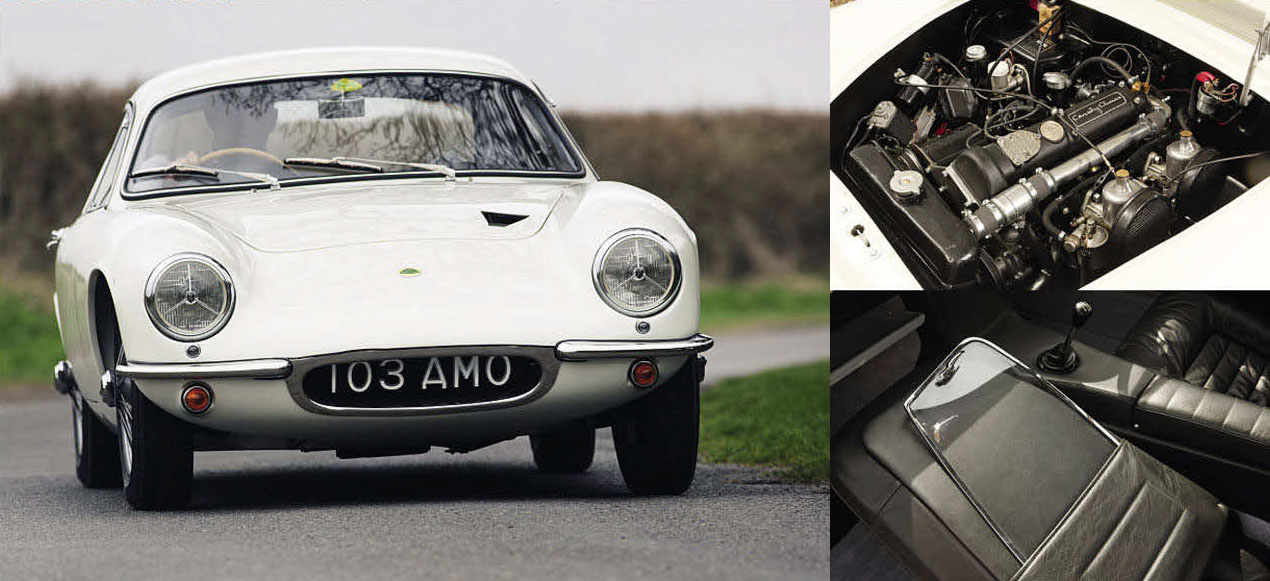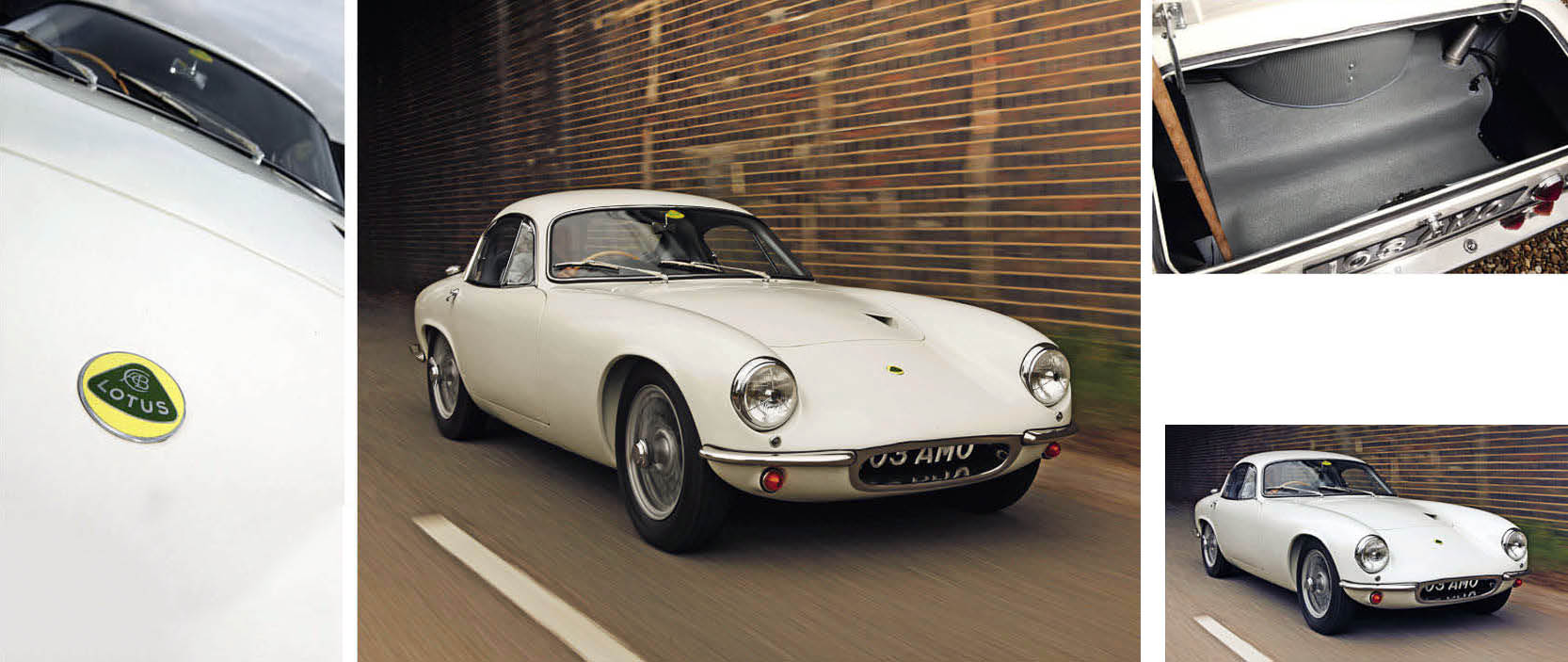
‘New’ Lotus Elite. Driving a time machine back to 1957. Colin Chapman’s jewel reborn driving a box fresh Elite. New Old Stock. The stunning, glassfibre monocoque. Elite put Lotus on the map in the late ’50s. Graeme Hurst discovers what it’s like to drive a freshly built one. Photography Tony Baker.
It’s a shame that only Dr Who has access to the Tardis. Wouldn’t it be great if you could pop in, dial up the launch date of your ideal classic and reappear at Earls Court for the introduction? Perhaps it’s October 1957 and you’re on the lookout for a new sports car that’s the talk of the show. All around you is a sea of cart-sprung machinery powered by cast-iron, pushrod boat anchors. But what’s this? A stunning little coupé boasting an all-alloy overhead-cam engine, independent rear suspension and state-of-the-art glassfibre construction? It’s about as different to the massed Fords and Vauxhalls as a dainty cup of espresso is to a builder’s mug of tea. And it’s on sale from Lotus, a young upstart firm with a reputation for inspiring keen drivers by offering thinly disguised racing cars for the road…
One Lotus enthusiast in effect lived out this time-travel dream when he spotted a job-lot for sale, plus the burnt-out remains of an original Elite. The kit contained a replacement shell produced from the factory’s moulds by Tony Bates, a well-known Elite owner when the cars were new. It was one of a dozen he created in the ’90s to help out people with battle-scarred originals.

Slender wood-rimmed wheel typifies Chapman’s minimalist engineering ethos; it perfectly frames rev counter and speedo.
Bates marketed them by laying up one shell complete with a raft of rare previously unused Elite components in a copycat of Lotus founder Colin Chapman’s PR stunt in period when he displayed the car in component form at shows.
The project was up for grabs in the early noughties at the Club Lotus Donington Park show. A complete ‘kit’ for a new Elite hadn’t been seen since the model was superseded by the Elan in 1963 and it was quickly snapped up. But it remained unpacked through several changes of ownership until three years ago, when former Elise owner Ian Ingram got to play out his Meccano fantasises in partnership with Tolman Motorsport and build a new Elite… 53 years after the world’s first glassfibre monocoque coupé made its debut at the Earls Court event.
Back then the Elite was hot news. Chapman had only been in business for five years, though his ‘add lightness’ engineering philosophy and maverick entrepreneurial spirit clearly underpinned his creativity. A closed-cockpit sports car was also a departure from Lotus’ inspiring previous efforts, especially with a monocoque. Yet its performance sounded promising for the late 1950s: just 1450lb in weight (658kg) with 75bhp from its FWE motor, a bespoke 1216cc version of the proven Coventry Climax Feather Weight engine for Automobiles, or FWA.
The idea of a body lacking any form of steel to hold the four corners together – apart from a bonded-in cradle to support the engine and front suspension, plus a bracing loop for the windscreen and jacking points – sounded alarming but boy did it look gorgeous! Those lines were largely thanks to one Peter Kirwan-Taylor.

Clockwise: fine grip and flat cornering; famous Godiva motif adorns cam cover of FWE engine; side windows slot in seatbacks; spare is stowed in cabin.
The then-unknown accountant with a flair for design devised the shape in collaboration with aerodynamicists Frank Costin and John Frayling, assisted by Chapman and Ron Hickman, who rationalised how it was going to be made. The attractive appearance helped to detract from any scepticism about the Elite’s construction, but Chapman wasn’t remotely fazed by critics. He was keen to be recognised as a fully fledged manufacturer so that he could fund his racing activities, although that step up would arguably only come with the Elite’s successor.
The Elite’s debut generated plenty of interest from show goers including Princess Margaret who famously asked to sit in the car. Here was a PR gift that Chapman narrowly missed out on after the locks jammed and had to be picked.
Hasty installation of components raided from corporate parts bins had a hand in that incident. The attention continued when the press got to experience the engineering under the gelcoat, although only as initial driving impressions – Chapman didn’t allowed full tests until January 1960. The Coventry Climax motor was a known entity, famous for its origins as a fire pump – surely the world’s only overhead-cam unit to fulfil such a prosaic function – and had been used in other Lotus sports-racers. But the independent rear suspension was new for a road car.
Borrowed from Chapman’s MkXII racer, the set-up features a MacPherson-like upright (the ‘Chapman strut’) and some clever lateral thinking in which the fixed-length driveshaft plays a crucial role in combination with a lower trailing radius arm to control the geometry and keep weight down. Inboard disc brakes with aluminium calipers kept unsprung weight to a minimum, likewise the use of glassfibre for what the springs were suspending. It all added up to a car with sparkling performance and near-neutral handling – one that allowed spirited drivers the chance to average 60mph on ordinary roads without going over 70, as Stirling Moss once remarked after stepping out of an Elite.
Ingram’s car, which carries the chassis number and registration of the fire-damaged Series II he bought, still has fewer than 200 miles on the clock after a fastidious nine-month build. So it presents the perfect opportunity to see what the fuss was about. And it doesn’t disappoint.
From the moment you press the (Hillman Husky-sourced) door-button, Chapman’s obsession with mass is immediately obvious; the panel is featherweight and the cockpit looks spartan.
There’s plenty of legroom considering the car’s dimensions – a shade over 12ft long – but anyone over 6ftmayfind the view cut off by the top of the ’screen. The wheel seems dainty and the pedals almost spindly but on the move the controls add to the car’s tactile nature, characterised by light yet precise inputs. There’s a delicious delicacy to it all – only the slick BMC-sourced ’box shows its age, with a lack of synchromesh on first.
The suspension has a decent amount of travel (more on that later), although the body feels remarkably rigid – as you’d expect from a new shell, free from five decades of fatigue. Consequently, it feels planted and composed on the road, but it doesn’t quite have the addictive sharpness of an Elan in the twisty bits.
Stretch the Elite’s legs as the bends begin to straighten and the Lotus’ decidedly short gearing is soon revealed: the tachometer needle is nudging 5500rpm at the legal limit. That’s no big deal because you need to rev the Coventy Climax unit hard before it rewards with pace. All the action only really takes place above 4000rpm, while the resulting frenetic mechanical soundtrack gives the car a lot of charisma.
Ah, yes… noise. The Elite’s one standout vice – as well as the characteristic whiff of glassfibre resin when the car gets warm – is the din inside. The unitary plastic tub acts like a drum as it amplifies rough surfaces and the engine’s thrum. Nodoubt a lot of that could be engineered out today, thanks to our understanding of the science of Noise, Vibration and Harshness (NVH), but it probably wasn’t so noticeable by the standards of the period. And it was worth putting up with the cacophony to enjoy the wonderful balance and exquisite styling: the Elite surely ranks as one of the all-time design gems.
Just like an early fixed-head E-type, it looks spot-on from any angle, with neat detailing. The inspired placement of slim, stainless-steel front bumpers hides joins in the bodyshell. Using Perspex windows maintains the profile (the technology to bend glass in three planes hadn’t yet been developed), while making them removable shaved weight and maximised interior space, too. No surprise, then, that the drag coefficient was particularly impressive for ’57, at 0.29, and the airflow of the shell so near optimum that wipers often aren’t needed at speed in the wet, as many an Elite owner experiencing a visit from the ‘Prince of Darkness’ Joe Lucas will attest.
The Elite evolved with various improvements, most notably in July 1960 with the launch of the MkII, which featured twin SU carburettors, a different design for the inside of the doors and wishbones at the back (in place of the lower trailing radius arm) for more robust location.
Chapman also offered a series of performance options, initially with the Super 95 in May ’62 and later the 100 and 105. The numbers represented the power output that came from using twin side draught carbs and a hotter camshaft.
The driving experience of this car has been enhanced via hidden tweaks such as rose-jointed rear wishbones and a properly threaded pinion-to- rack housing instead of the original’s pressed-fit arrangement. Both were done in the interest of safety, plus Tolman also improved the damping and spring rates with bespoke rear struts – courtesy of a clean-sheet approach using race-derived software (Specialist, January 2012).
That’s the bonus of having a kit to work with, notably one being screwed together five decades on. A combination of time and modern engineering makes it possible for specialists to carry on where Chapman left off with subtle upgrades that he didn’t have the luxury of indulging in.
Or self-build owners for that matter. The Elite was offered as a kit from October 1961 to boost home-market appeal, the same route that Lotus took with the Seven. This option shaved £363 off the price – which reflected the labour intensive cost of laying up the shell – although the cars weren’t exactly kits; the body was delivered painted, with wiring and glass in place.
The step-change in production came with the Elan. It was speedier down the line thanks to a novel sheet-steel fabricated central backbone that allowed for a vastly simpler glassfibre shell to be mated to it. The Elan 1500 undercut the Elite by £350 and outsold it within the first year.
Without the Elite, though, Lotus wouldn’t have been propelled from hand-to-mouth constructor to bona fide manufacturer. The ground breaking coupé also extended the firm’s reputation into closed-cockpit racing. Between 1959 and ’64, Elites took first in class at Le Mans Each year with a couple of podium places in the Index of Thermal Efficiency.
Success at La Sarthe spawned further variants, including a 750cc Climax twin-cam-powered car driven by Bob McKee and Cliff Allison in a quest to clinch the Index of Performance in 1961. There had also been a 2-litre version prepared for Innes Ireland a year earlier, but withdrawn. Several encouraging results at the Sebring 12 Hours boosted sales in the United States, too, where its light weight and modest capacity was even more of a contrast to Detroit iron.
By September 1963, the Elite made way for the Elan at the Cheshunt factory. The production figure was famously fudged by Chapman – no doubt in a quest for Lotus to punch above its weight – but model experts agree that just over 1000 were built. Around 87% survive, which is impressive, but a combination of the Elite’s fragile construction and begs-to-be-driven dynamics means that many have been subject to substantial repairs and upgrades, often of varying quality.
Which is why Ingram’s ‘new’ car is such a treat. Pick a quiet B-road to explore its performance and the clock quickly rewinds to October ’57 as you blast your way home from Earls Court while savouring the delights of a car that stands out as one of Chapman’s all-time greats.
Thanks to Tolman Motorsport (08452 306205; www.tolmanmotorsport.co.uk)
‘MODEL EXPERTS AGREE THAT ABOUT 1000 WERE BUILT – 87% SURVIVE, WHICH IS IMPRESSIVE’

From top: initials of Anthony Colin Bruce Chapman; Kirwan-Taylor’s styling isn’t just pretty, Elite has 0.29 Cd; limited boot space around tank.
‘MOSS ONCE AVERAGED 60MPH ON ORDINARY ROADS IN AN ELITE AND DIDN’T GO OVER 70MPH’
Fancy one with more power Lotus Elite Type 14 Super 125?
The Lotus Elite Type 14 Super 125 badge on this Elite is the tongue-in-cheek finishing touch to a project driven by a lifelong Lotus enthusiast’s desire to improve on Chapman’s genius using a 1961 example that had been badly restored.
“I bought it three years ago but quickly realised it wasn’t sorted, so it was a case of sell it on or get it right,” recalls Christopher Ross, whose engineering background meant that he couldn’t resist fettling his Elite. What started as a suspension check with Tolman led to a piece-by-piece re-engineering of the car.
First up were stiffer springs and dampers, plus wider, bespoke front wishbones for extra camber. Other mods include a better located, higher-ratio rack, along with rose-jointed rear wishbones to accurately control toe-in and camber.
A dual-bias adjustable pedal box helps to optimise the race-spec brakes, while a smaller steering wheel and modern (but period finished) seats increase comfort.
The gearshift action has also been improved by machining-in end-stops for the selector shafts. There’s a raft of refinements to help extract performance reliably, including titanium valves and spring retainers, plus a sump-stiffening plate (bolted to an extended main-bearing cap) and a forged crank mated to an alloy flywheel.
A heady 12:1 compression ratio and repro filed cam, along with tuned-length manifolds, help to deliver dyno figures worthy of the badge.
It all equates to scintillating performance that almost defies the engine’s size. There’s little torque below 4000rpm but the top end is fierce, with the 1216cc unit happily shrieking up to 8000rpm. It’s seriously highly strung, but the care with which it’s been screwed together – every thread in the block has a steel insert – means that the alloy engine can be revved with impunity while the suspension upgrades allow the power to be used effectively. Chapman would undoubtedly have approved.

From top: Super 125 looks stock; badge is a nod to period Elite upgrades; feisty re-engineered ‘four’ readily spins to 8000rpm.
TECHNICAL DATA LOTUS ELITE
Sold/number built 1959-1963/1030 (all versions)
Construction glassfibre monocoque
Engine all-alloy, single-overhead-cam 1216cc ‘four’, with twin SU carburettors
Max power 75bhp @ 6100rpm
Max torque 75lb ft @ 4750rpm
Transmission four-speed manual, driving rear wheels
Suspension independent all round, at front by double wishbones, coil-over-dampers rear Chapman struts, lower trailing wishbones
Steering rack and pinion
Brakes discs all round (inboard at rear)
Length 12ft 3in (3733mm)
Width 4ft 10 ½ in (1486mm)
Height 3ft 11in (1194mm)
Wheelbase 7ft 4in (2240mm)
Weight 1450lb (656kg)
0-60mph 11.8 secs
Top speed 115mph
Mpg 32-38
Price new £1662 (£1299 in component form)
Price now £85,000





